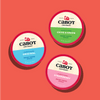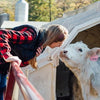
Unsalted Butter: The Key to Flavor Control in Baking
Butter production uses about one-third of all the milk produced in the world. The reason for that staggering fact is that butter is a staple food used around the world. When you’re shopping for butter in the store, you have your choice of salted vs. unsalted. But which is the best butter for baking or cooking? This guide gives you the facts about salted vs. unsalted butter, so you can choose the right type for every recipe.
What’s the difference between salted butter and unsalted butter?
The name gives you a clue! All that separates salted butter from unsalted butter is salt. Both types of butter start off as cream, but salted butter has salt added to enhance the flavor. The presence of the salt gives the butter 10 to 18% more water content, and it extends the life of butter, allowing it to last for about 5 months versus the usual 3-month shelf life of unsalted butter.
How much salt goes into salted butter varies by brand. The more salt butter contains, the more noticeable the flavor difference between salted and unsalted butter. When you use salted butter, the added seasoning ultimately ends up in your food, affecting its flavor. That’s why many people say unsalted is the best butter for baking and some prefer salted butter for cooking and spreading.
This table gives you a breakdown of the key differences between the two types of butter.
| Salted Butter | Unsalted Butter | |
| Differences: | Contains salt and more water | Free of salt and contains less water |
| When to use: | All-purpose but not usually recommended for baking | All-purpose and ideal for baked goods |
| Benefit: | Enhances flavor | Controls flavor & helps process gluten in baked goods |
| Conversion: | Remove ¼ tsp of salt from the recipe | ½ cup unsalted butter plus ¼ tsp of salt |
What is unsalted butter used for?
Anytime that you want the ingredients in your recipe to take center stage, and you don’t want the added flavor of salt, unsalted butter is typically the better option. Since levels of salt in salted butter vary, opting for unsalted can help ensure that recipes taste the same every time that you use them. This is especially important in baking because of the need to balance sweetness and saltiness.
The added water content in salted butter can also affect baking recipes. If you use salted butter, the excess water can interfere with the gluten production process, which in turn can give you unexpected results in terms of the texture and crumb of your baked goods.
Cabot’s Extra Creamy Premium Unsalted Butter is a great option anytime a recipe calls for butter and you want to preserve the flavor profile and moisture content. We slow churn straight-from-the-farm cream for an extended period to deliver a richer, creamier finished product.
Why do we use unsalted butter in baking?
In the choice between salted or unsalted butter for baking, unsalted butter comes out on top because baking is all about consistency. Every time that you bake something, a little science happens in your oven. Reactions take place that turns batter into cakes, bread, brownies, cookies and other favorite foods. For those reactions to occur in a predictable way, you need to control what goes into your recipes.
Since there is no standard formula for how much salt goes into salted butter, you won’t know how a particular stick may impact your recipe. You could end up with an undesirable texture or consistency or be able to taste salt in the finished products. What’s especially maddening is that one brand’s salted butter might not have any detrimental effect but another brand’s will due to increased salt and water content. Sticking with unsalted butter gives you more foolproof results and allows the sweet cream taste of butter to truly shine.
What is salted butter used for?
Salted butter is all-purpose, meaning you can use it in a variety of ways. Spread some on your favorite crusty bread for a snack or a side at a meal. Use it to top off veggies or pasta. You can also use it in cooking recipes when you’re not concerned about controlling the amount of salt or think the dish can benefit from the added zip of the seasoning.
Cabot’s Extra Creamy Premium Sea Salted Butter is a versatile hero in the kitchen that works equally well as a topping for popcorn, a spread for a slice of bread or croissant or an accompaniment for baked shellfish and seafood.
Can you use salted butter when a recipe calls for unsalted?
A lot of testing and refinement goes into recipes, so it’s usually best to follow whatever the recipe says. This is especially true when you’re baking. Using salted butter in place of unsalted or vice versa can lead to catastrophes just like putting in too much flour or forgetting baking soda can.
That said, you may not always have both kinds of butter in your kitchen, and if you find yourself having to quickly whip up a batch of cookies for the bake sale you forgot about or having to redo a recipe because of a kitchen mishap like forgetting to set the oven timer, you may not have the luxury of being able to follow the ingredients list to the letter. When you’re in a pinch, you can substitute salted butter for unsalted or unsalted for salted by following this guide:
Salted Butter to Unsalted Butter Conversion: ½ cup salted butter = ½ cup unsalted butter + ¼ teaspoon of salt
So, if you’re using salted butter in place of unsalted, you’ll want to use the same amount but subtract ¼ teaspoon of salt from the ingredients. To go from unsalted to salted, use the same amount of butter but add ¼ teaspoon of salt.
Can you freeze your unused butter?
While we can only guarantee our butters until the sell-by date printed on the packaging, many people do freeze butter with success. Typically, unsalted butter can last for 6 months in the freezer, and salted butter has a freezer life of around a year. Make sure that you wrap the butter in plastic freezer wrap or heavy-duty aluminum foil and then put it inside of a freezer bag to prevent freezer burn.
Now that you know the difference between salted and unsalted butter, you can select the best butter for baking or cooking any recipe. For added fun, you can even try making your own unsalted, salted or flavored butter with this guide.



















Comments
janmaus said:
The first time I was served unsalted butter as table butter, it was kind of shocking—I thought it tasted like cream instead of the buttery flavor I’d grown up with. But after having spent years as an ex-pat in the middle east and Europe, I love it. I use it both for cooking and as a table spread.
Antonia DeLuca said:
I love your products and have made many of your recipes. Thank you.
Michele Katurah Buros said:
Cabot Butter is the only butter I use! It is really difficult finding your butter and cheese products in our area (Monroeville, PA). Some (Latrobe/Mt. Pleasant) Walmarts or Sam’s Clubs do carry a nice line of Cabot products, but I do wish I could find the more products in ALL the local grocery stores especially Giant Eagle and Shop N Save.
Rose said:
Thanks for the explanation. I have used salted for everything and occasionally my cookies are flat and too thin. Now I know why.